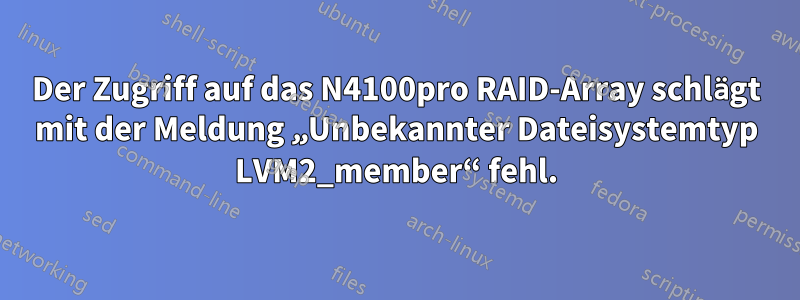
Mein altes NAS Thecus N4100pro NAS ist leider kaputt gegangen. Nun versuche ich über die Knoppix Linux Live-CD (http://www.knoppix.org/).
Ich habe die Festplatten über USB mit einem UGREEN USB3-zu-SATA III-Adapter angeschlossen.
Problem:
Ich bekomme die Nachricht
root@Microknoppix:/mnt# mount -v /dev/md1 /mnt/md1
mount: /mnt/md1: unbekannter Dateisystemtyp „LVM2_member“.
Auf Englisch: „unknown file system type „LVM2_member““
Einzelheiten:
root@Microknoppix:/mnt# mdadm --examine --scan
ARRAY /dev/md/0 metadata=1.0 UUID=5edde908:9048aaa5:531e34df:d19abc2a name=N4100PRO:0
ARRAY /dev/md1 UUID=a55eb74f:8ae45a12:a3cc9d60:ef284003
root@Microknoppix:/mnt# mdadm --assemble --scan
mdadm: No arrays found in config file or automatically
root@Microknoppix:/mnt# cat /proc/mdstat
Personalities : [raid1] [raid6] [raid5] [raid4]
md0 : active (auto-read-only) raid1 sdg1[0] sdf1[1] sde1[2] sdd1[3]
1959884 blocks super 1.0 [4/4] [UUUU]
md1 : active (auto-read-only) raid6 sdg2[3] sdf2[2] sde2[1] sdd2[0]
2926352000 blocks level 6, 64k chunk, algorithm 2 [4/4] [UUUU]
unused devices: <none>
mdadm -D /dev/md1:
knoppix@Microknoppix:~$ sudo mdadm -D /dev/md1
/dev/md1:
Version : 0.90
Creation Time : Thu Apr 1 20:54:30 2010
Raid Level : raid6
Array Size : 2926352000 (2790.79 GiB 2996.58 GB)
Used Dev Size : 1463176000 (1395.39 GiB 1498.29 GB)
Raid Devices : 4
Total Devices : 4
Preferred Minor : 1
Persistence : Superblock is persistent
Update Time : Wed Jan 17 03:52:41 2007
State : clean
Active Devices : 4
Working Devices : 4
Failed Devices : 0
Spare Devices : 0
Layout : left-symmetric
Chunk Size : 64K
Consistency Policy : resync
UUID : a55eb74f:8ae45a12:a3cc9d60:ef284003
Events : 0.5848
Number Major Minor RaidDevice State
0 8 50 0 active sync /dev/sdd2
1 8 82 1 active sync /dev/sdf2
2 8 98 2 active sync /dev/sdg2
3 8 114 3 active sync /dev/sdh2
lvmdiskscan:
knoppix@Microknoppix:~$ sudo lvmdiskscan
/dev/sde: open failed: Kein Medium gefunden
/dev/ram0 [ 4,00 MiB]
/dev/md0 [ <1,87 GiB]
/dev/ram1 [ 4,00 MiB]
/dev/sda1 [ 350,00 MiB]
/dev/md1 [ <2,73 TiB] LVM physical volume
/dev/ram2 [ 4,00 MiB]
/dev/sda2 [ 231,68 GiB]
/dev/ram3 [ 4,00 MiB]
/dev/sda3 [ 876,00 MiB]
...
/dev/sdb1 [ 232,88 GiB]
/dev/sdc1 [ <1,82 TiB]
0 disks
22 partitions
0 LVM physical volume whole disks
1 LVM physical volume
lvscan:
knoppix@Microknoppix:~$ sudo lvscan
/dev/sde: open failed: Kein Medium gefunden
inactive '/dev/vg0/syslv' [1,00 GiB] inherit
inactive '/dev/vg0/lv0' [<2,59 TiB] inherit
Volumegruppen aktivieren:
knoppix@Microknoppix:~$ sudo vgchange -ay
/dev/sde: open failed: Kein Medium gefunden
2 logical volume(s) in volume group "vg0" now active
Nun sind beide Volume-Gruppen aktiv:
knoppix@Microknoppix:~$ sudo lvscan
/dev/sde: open failed: Kein Medium gefunden
ACTIVE '/dev/vg0/syslv' [1,00 GiB] inherit
ACTIVE '/dev/vg0/lv0' [<2,59 TiB] inherit
Nun ist es möglich, die Volume-Gruppe zu mounten:
knoppix@Microknoppix:/mnt$ sudo mount -o ro /dev/vg0/lv0 /mnt/thecus
Dieser Artikel hat geholfen:
- https://en.wikipedia.org/wiki/Logical_Volume_Manager_(Linux)
- https://www.svennd.be/mount-unknown-filesystem-type-lvm2_member/
Es wäre toll, wenn mir jemand helfen könnte, meine Daten zurückzubekommen.
Danke!
Antwort1
Die Lösung ist in meiner obigen Frage dokumentiert.
Die Lösung bestand darin, die Datenträgergruppe zu finden und diese anstelle des „RAID-Geräts“ direkt zu mounten.


